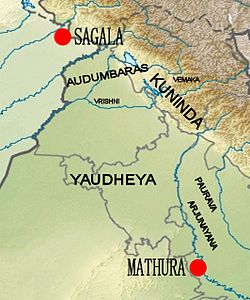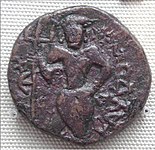| Kingdom of Kuninda | |||||||
|---|---|---|---|---|---|---|---|
| Before 2nd century BCE–3rd century | |||||||
 Silver coin of the Kuninda kingdom, c. 1st century BCE. These coins followed the Indo-Greek module.
Silver coin of the Kuninda kingdom, c. 1st century BCE. These coins followed the Indo-Greek module.Obv: Deer standing right, crowned by two cobras, attended by Lakshmi holding a lotus flower. Legend in Prakrit (Brahmi script, from left to right): Rajnah Kunindasya Amoghabhutisya maharajasya ("Great King Amoghabhuti, of the Kunindas"). Rev: Stupa surmounted by the Buddhist symbol triratna, and surrounded by a swastika, a "Y" symbol, and a tree in railing. Legend in Kharoshti script, from right to left: Rana Kunidasa Amoghabhutisa Maharajasa, ("Great King Amoghabhuti, of the Kunindas"). | |||||||
 150 BCESATAVAHANASMAHAMEGHA- VAHANASSAMATATASAUDUMBARASYAUDHEYASPAURAVASVRISHNISKUNINDASINDO- GREEKSGRECO- BACTRIANSMITRASARJUNAYANASMALAVASSHUNGASPANDYASCHOLASCHERASLOULANHAN DYNASTYclass=notpageimage| Location on the Kunindas and contemporary South Asian polities circa 150 CE. | |||||||
 Location of Kuninda relative to other groups: the Audumbaras, the Vemakas, the Vrishnis, the Yaudheyas, the Pauravas and the Arjunayanas. Location of Kuninda relative to other groups: the Audumbaras, the Vemakas, the Vrishnis, the Yaudheyas, the Pauravas and the Arjunayanas. | |||||||
| Government | Monarchy | ||||||
| History | |||||||
| • Established | Before 2nd century BCE | ||||||
| • Disestablished | 3rd century | ||||||
| |||||||
| Today part of | India Nepal | ||||||
The kingdom of Kuninda (or Kulinda in ancient literature) was an ancient central Himalayan kingdom documented from around the 2nd century BCE to the 3rd century CE, located in the southern areas of modern Himachal Pradesh and far western areas of Uttarakhand in northern India and Doti Gadwall in Nepal.
Kingdom
The first mention of Kuninda appears in Panini Ashtadhyay where he mentions it as an Ayudhajivi Sangha, meaning a warrior republic. Though, the kingdom may have existed earlier as it is also mentioned in Mahabharat to be situated in the east of kuru kingdom. The history of the kingdom is documented from around the 2nd century BCE. They are mentioned in Indian epics and Puranas. The Mahabharata relates they were defeated by Arjuna.
One of the first kings of the Kuninda was Amoghbhuti, who ruled in the mountainous valley of the Sutlej and Yamuna rivers (in today's southern Himachal and far western Uttarakhand in northern India).
The Greek historian Ptolemy linked the origin of the Kuninda to the country where the rivers Beas, Sutlej, Yamuna, and Ganges originate.
One of the Edicts of Ashoka on a pillar is also present at Kalsi, in the region of Garhwal, indicating the spread of Buddhism to the region from the 4th century BCE.
The Kuninda kingdom disappeared around the 3rd century, and from the 4th century, it seems the region shifted to Shaivite beliefs.
Coinage
There are two types of Kuninda coinage, the first one issued around the 1st century BCE, and the second around the 2nd century CE. The first coins of the Kuninda were influenced by the numismatic model of their predecessor Indo-Greek kingdoms, and incorporated Buddhist and Hindu symbolism such as the triratna and images of Lakshmi. These coins typically follow the Indo-Greek weight and size standards (drachms, of about 2.14 g in weight and 19 mm in diameter), and their coins are often found together with Indo-Greek coins in hoards, such as those of the Yaudheyas, or the Audumbaras.
The finds of Kuninda coins have often been associated with finds of Indo-Greek coins, particularly those of Appolodotus.
A very large portion of the Kuninda coins are in the name of king Amoghabhuti, and it is believed that coinage under his name continued after his death.
Some later coins of the 2nd century CE bear the symbol of the Hindu god Shiva.
Gallery
-
 Coin of the Kunindas.
Coin of the Kunindas.
Obv Shiva standing with battle-axe trident in right hand and leopard skin in left hand. Legend Bhagavato Chatreswara Mahatana.
Rev Deer with symbols. -
 Shiva with trident, Kuninda, 2nd century CE.
Shiva with trident, Kuninda, 2nd century CE.
Rulers
- Amoghabhuti (late 2nd century-1st century BCE)
See also
References
- "A Maharaja named Amoghabhuti, who was the Raja of the Kunindas, is known from coins of the Indo-Greek module with legends sometimes in both Brahmi and Kharoshthi, but in some cases in Brahmi only." in The History and Culture of the Indian People, Volume 2 by Ramesh Chandra Majumdar, 1951, page 161
- Schwartzberg, Joseph E. (1978). A Historical atlas of South Asia. Chicago: University of Chicago Press. p. 145, map XIV.1 (d). ISBN 0226742210.
- Agrawala, V. S. (1953). India as Known to Panini - VS Agrawala. University of Lucknow.
- Ptolemy, Geography 7.1.42: ὑπὸ δὲ τὰς Βιβάσιος καὶ τοῦ Ζαράδρου καὶ τοῦ Διαμούνα καὶ τοῦ Γάγγου ἡ Κυλινδρινή, "and enclosed by the Bibasis, the Zaradros, the Diamuna, and the Ganges is Kylindrinē."
- ^ A pageant of Indian culture: art and archaeology by Asoke Kumar Bhattacharyya p.156ff
External links
| State of Himachal Pradesh | |||||||
|---|---|---|---|---|---|---|---|
| Capital: Shimla | |||||||
| Topics | |||||||
| History | |||||||
| Culture | |||||||
| Jurisdiction | |||||||
| Districts and divisions |
| ||||||
| Major cities | |||||||
| Economy | |||||||
| Geography | |||||||
| Images and others | |||||||
| State of Uttarakhand | |||||||||||||||||||
|---|---|---|---|---|---|---|---|---|---|---|---|---|---|---|---|---|---|---|---|
| State capitals: legislative: Dehradun (winter); Bhararisain (summer); judicial: Nainital | |||||||||||||||||||
| Government |
| ||||||||||||||||||
| History |
| ||||||||||||||||||
| Geography and ecology |
| ||||||||||||||||||
| Demographics |
| ||||||||||||||||||
| Administrative divisions |
| ||||||||||||||||||
| Politics | |||||||||||||||||||
| Tourism |
| ||||||||||||||||||
| Sports | |||||||||||||||||||
| Other topics | |||||||||||||||||||
| Districts |
| ||||||||||||||||||
| Major cities | |||||||||||||||||||